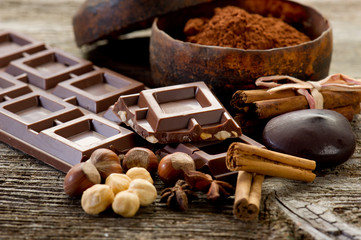All About Chocolate

Chocolate
All About Chocolate
Just say the word “Chocolate,” and you evoke a visceral reaction in people… Mouths water, pupils dilate and stomachs rumble. You rarely hear someone say, “No chocolate for me.” Or, “I’m gonna pass on that chocolate cake.” Ever hear, “I need some chocolate?” All the time. Why is this? Does chocolate have some mystical power over us? How do our chocolate cravings make us drive to the store at 3am, just so we can experience that smooth texture and sweet aftertaste? One thing is for sure, there is a chemical component present in chocolate that does not exist in other foods.
A brief history…
No one knows exactly where chocolate was first discovered, and by whom. Its believed to have first been cultivated between two and four thousand years ago in the Amazon. During the sixth century AD, the Mayas called the tree cacahuaquchtl… “tree,” and the word chocolate comes from the Maya word xocoatl which means bitter water. To the Mayan culture, the cocoa pods represented fertility. By 600 AD the Mayan civilization had expanded to the Pacific Coast of Guatemala. In the Yucatan, the Mayans were thought to be the first to grow cocoa, where the bean was used in religious ceremonies. In the year 1200, the Aztecs began cultivating the dark beans. The Aztecs and Mayans both contributed to the creation of xocoatl, a drink believed to bring healing and health.
After the cultivation of chocolate by the Mayans and Aztecs, Columbus came across the cocoa bean and introduced it in Nicaragua, then to Europe. In 1528, chocolate arrived in Spain. Hernando Cortes presented cocoa beans to the Spainish King, Charles V and the necessary tools for its preparation. With these beans, Cortès taught him how to make Chocolatl (chocolate). After experimenting with its preparation, Cortes began to experiment with spices like nutmeg, cinnamon, and sugar to make it a pleasant, less bitter drink. In 1585, the first batch of beans intended for market arrived in Spain. In the early part of 1600, chocolate made its way to Paris, then London. Soon after, Brazil, Zurich, Germany and Belgium began manufacturing chocolate. Finally, in 1755, chocolate found its way to North America, and in 1765 the first chocolate factory began churning out product. The rest, as they say, is history!
Manufacturing:
If you’ve ever seen a chocolate pod picked from a tree, you may wonder how something so ugly could produce such an amazing taste sensation. The creation of chocolate is a long, and arduous procedure. First, the ripe cocoa pods must be cut from the trees, then split open. The pulp inside is scraped out, and laid on a flat surface to ferment. After a few days, workers separate the dried seeds from the pulp. The seeds are bagged, then shipped to market. The seeds are cleaned again after they arrive at their final destination. Afterwards, they are roasted to loosen their husks. The husks are separated from the inner portion, or nibs. What is done next with these nibs controls the type and quality of the chocolate.
The nibs are ground under heavy stone mills that look like large stone wheels, and oil from the nibs is released. This oil is chocolate liquor, a thick substance that when hardened makes truly bitter chocolate. When cocoa butter is added, it becomes a palatable creation. Cocoa butter is attained when part of the fat is removed from the original mass. Cocoa butter is essential in producing a sweet, edible piece of chocolate. Other ingredients may be added at this juncture.
Depending on how much cocoa butter is added determines the pureness of the chocolate that you are eating. For example, if you have a chocolate bar that read 65% cocoa on the label, that means 35% cocoa butter and other fillers have been added. Cocoa isn’t inherently sweet, so more cocoa does not create a more palatable product. Still, it’s a matter of taste – A chocolate bar with a large percentage of cocoa may be bitter and unpleasant to some people, while others find a lower percentage too sugary and sweet.
Different Types of Chocolate:
Dark Chocolates
Baker’s chocolate is 100% cocoa solids and cocoa butter. Good, dark eating chocolate usually has a minimum of 60% cocoa solids, plus about 30% cocoa butter. Sugar and vanilla composes the remainder of dark eating chocolate.
Milk Chocolate
Milk chocolate contains from 11 to 20 percent cocoa solids. Its other ingredients are milk (about 20 percent), flavorings and sugar (up to 65 percent). Milk chocolate is high in lecithin, a vegetable oil used to replace natural cocoa butter.
White Chocolate
White Chocolate isn’t a true chocolate. Here’s why… White chocolate contains no cocoa solids. It does contain cocoa butter, but it’s combined with milk, sugar and other flavoring ingredients, like vanilla. In order to be labeled “chocolate” (as defined in the United States by the Food and Drug Administration), a product must also contain cocoa solids from chocolate liquor.
Couverture Chocolate
Couverture or coating chocolate is very high in both cocoa solids and cocoa butter. It’s the chocolate that professional candy makers use. It’s also the most heavily processed kind – extra grinding, blending and stirring make a smooth, flavorful product.
Cocoa Powder
Cocoa powder is made of cocoa solids, completely defatted and repeatedly ground. It is treated with alkali to make it more mixable in liquids and to reduce its astringency.
Yeah, that’s right… Health Benefits! Chocolate is good for you! That doesn’t mean you can gorge yourself, but in small portions, high-quality dark chocolate can be healthful. Antioxidants in chocolate aid the body in fighting free radicals that can cause premature aging and heart disease. Dark chocolate contains up to eight times the number of antioxidants found in strawberries. Good dark chocolate has also been shown to decrease blood pressure through the production of nitric oxide, and balance certain hormones in the body. And of course, in time for Valentine’s Day, it’s good to know that chocolate also acts as a natural aphrodisiac.
Chocolate… What’s not to like? It comes in so many forms, shapes, textures, and varieties. Eating this confection is such a great (and sometimes necessary) pleasure. We’re still in the beginning stages of truly learning what magical properties are contained in this solid mass. What we do know is that it is like nothing else in the world – a special sweet treat that can bring out a myriad of human emotions.
Happy Eating!
Chef Chuck Kerber






 in <b>/var/www/vhosts/cooksandeats.com/httpdocs/wp-content/themes/CooksandEats/sidebar.php</b> on line <b>1</b><br />
/wp-content/themes/CooksandEats/images/side-logo.png)



 in <b>/var/www/vhosts/cooksandeats.com/httpdocs/wp-content/themes/CooksandEats/footer.php</b> on line <b>13</b><br />
/wp-content/themes/CooksandEats/images/back-to-top.png)
I really liked reading your post!. Quallity content. With such a valuable blog i believe you deserve to be ranking even higher in the search engines :). Check out the link in my name. That links to a tool that really helped me rank high in google. This way even more people can enjoy your posts and nothing beats a big audiance 😉